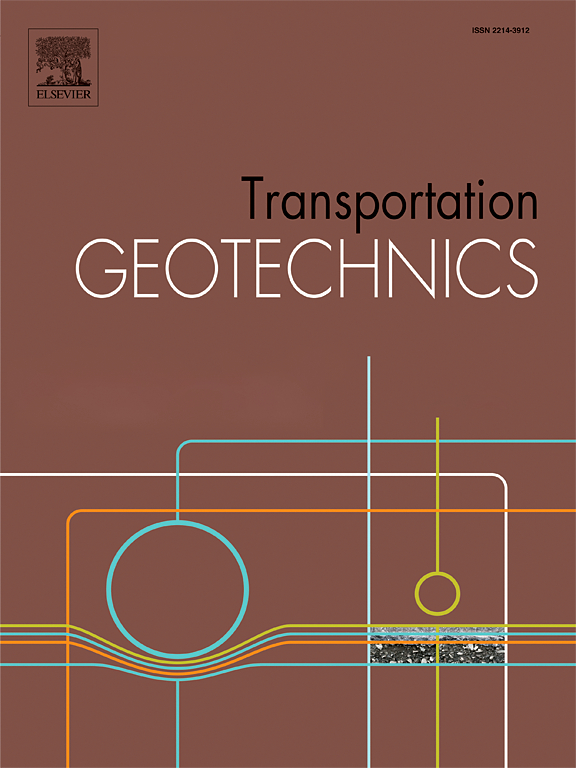Scanners, satellites, smart compactors, and drones: Emerging technologies for assessing compacted soil lift thickness
IF 4.9
2区 工程技术
Q1 ENGINEERING, CIVIL
引用次数: 0
Abstract
Effective soil compaction requires sufficient compactor energy penetration. To achieve this goal, soil compaction specifications typically mandate a “not to exceed” lift thickness for a given layer of soil that is placed, spread, and compacted. Traditional techniques for field monitoring of soil lift thickness are personnel dependent, and add cost and time to projects. New and innovative approaches are emerging that have the long-term potential for more effective lift thickness monitoring at reduced cost. Three of these techniques are discussed in the current paper: (1) non-destructive lift thickness scanning using a magnetic pulse induction lift thickness scanner (scanners), (2) continuous real-time kinematic (RTK) global positioning system (GPS) surveying using a global navigation satellite system (GNSS) such as GPS, GLONASS, BeiDou, Galileo, etc in conjunction with local receivers mounted on “intelligent” soil compactors (satellites and smart compactors), and (3) unmanned aerial vehicle (UAV) image acquisition coupled with photogrammetric analysis/surveying techniques (drones). The accuracy of point-specific measurements made using each of these techniques is of critical importance. This paper describes the results from a field study that was conducted to assess the relative accuracy of these three techniques by monitoring the lift thickness of a full-scale earthen test embankment. Measured field results indicated that emerging technologies such as magnetic pulse induction scanning can accurately estimate soil lift thickness within 0.4 cm when compared against physical soil lift thickness measurements. Other emerging technologies, such as UAV-based surveying techniques, also provided reliable estimates of soil lift thickness measurements, which were accurate to within 1.2 cm of physical soil lift thickness measurements. Additionally, some of these emerging techniques (satellites, smart compactors, and drones) offer the advantage of providing near-continuous soil lift thickness measurements along the entire embankment, which can be useful for building spatial maps of compacted soil lift thickness.
扫描仪、卫星、智能压实机和无人机:用于评估压实土壤抬升厚度的新兴技术
有效的土壤压实需要足够的压实机能量穿透。为了实现这一目标,土壤压实规范通常要求在放置、铺开和压实的给定土层上“不超过”抬升厚度。传统的土壤抬升厚度现场监测技术依赖于人员,并且增加了项目的成本和时间。新的创新方法正在出现,这些方法具有长期潜力,可以以更低的成本更有效地监测举升厚度。本文讨论了其中的三种技术:(1)使用磁脉冲感应升降机厚度扫描仪(扫描器)进行无损升降机厚度扫描;(2)使用GPS、GLONASS、北斗、伽利略等全球导航卫星系统(GNSS),结合安装在“智能”土壤压实机(卫星和智能压实机)上的本地接收器,进行连续实时动态(RTK)全球定位系统(GPS)测量;(3)无人机(UAV)图像采集与摄影测量分析/测量技术(无人机)相结合。使用每种技术进行的特定点测量的准确性至关重要。本文描述了一项实地研究的结果,该研究是通过监测全尺寸土测试路堤的升力厚度来评估这三种技术的相对准确性。实测结果表明,与物理测量结果相比,磁脉冲感应扫描等新兴技术可以准确地估计0.4 cm以内的土壤抬升厚度。其他新兴技术,如基于无人机的测量技术,也提供了可靠的土壤抬升厚度测量估计,其精确到物理土壤抬升厚度测量值的1.2厘米以内。此外,其中一些新兴技术(卫星、智能压实机和无人机)具有沿着整个路堤提供近乎连续的土壤抬升厚度测量的优势,这对于构建压实土壤抬升厚度的空间地图非常有用。
本文章由计算机程序翻译,如有差异,请以英文原文为准。
求助全文
约1分钟内获得全文
求助全文
来源期刊

Transportation Geotechnics
Social Sciences-Transportation
CiteScore
8.10
自引率
11.30%
发文量
194
审稿时长
51 days
期刊介绍:
Transportation Geotechnics is a journal dedicated to publishing high-quality, theoretical, and applied papers that cover all facets of geotechnics for transportation infrastructure such as roads, highways, railways, underground railways, airfields, and waterways. The journal places a special emphasis on case studies that present original work relevant to the sustainable construction of transportation infrastructure. The scope of topics it addresses includes the geotechnical properties of geomaterials for sustainable and rational design and construction, the behavior of compacted and stabilized geomaterials, the use of geosynthetics and reinforcement in constructed layers and interlayers, ground improvement and slope stability for transportation infrastructures, compaction technology and management, maintenance technology, the impact of climate, embankments for highways and high-speed trains, transition zones, dredging, underwater geotechnics for infrastructure purposes, and the modeling of multi-layered structures and supporting ground under dynamic and repeated loads.
 求助内容:
求助内容: 应助结果提醒方式:
应助结果提醒方式:


